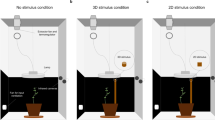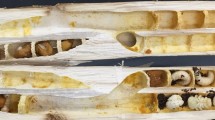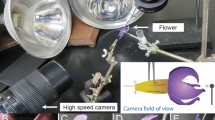Abstract
The release of stored elastic energy often drives rapid movements in animal systems1,2, and plant components employing this mechanism should be able to move with similar speed. Here we describe how the flower stamens of the bunchberry dogwood (Cornus canadensis) rely on this principle to catapult pollen into the air as the flower opens explosively3,4,5. Our high-speed video observations show that the flower opens in less than 0.5 ms — to our knowledge, the fastest movement so far recorded in a plant.
Similar content being viewed by others
Main
Cornus canadensis grows in dense carpets in the vast spruce-fir forests of the North American taiga. As bunchberry flowers burst open, their petals rapidly separate and flip back to release the stamens (Fig. 1). During the first 0.3 ms, the stamens accelerate at up to 24,000±6,000 m s−2 (2,400g), reaching the high speed (3.1±0.5 m s−1) necessary to propel pollen, which is light and rapidly decelerated by air resistance (terminal velocity, 0.12±0.03 m s−1 (mean±s.e.m.); n=7). The pollen granules are launched to an impressive height of 2.5 cm (range, 2.2–2.7 cm; n=5), which is more than ten times the height of the flower: from this height, they can be carried away by the wind. (For methods and movies, see supplementary information.)
Petals open independently of stamen activity, moving out of their way within the first 0.2 ms (Fig. 1). Petals attain a maximum speed of 6.7±0.5 m s−1, accelerating at up to 22,000±6,000 m s−2 (or 2,200g). The process of petal opening and pollen launch in bunchberry plants occurs faster than the opening of Impatiens pallida fruits (2.8–5.8 ms, n=3, see supplementary information); the snap of venus flytraps (Dionaea muscipula; 100 ms)6; the leap of froghoppers (Philaenus spumarius; 0.5–1.0 ms)1; or the strike of the mantis shrimp (Odontodactylus scyllarus; 2.7 ms)2.
As in these other organisms1,2,6, rapid movements in bunchberry flowers rely on stored mechanical energy. Physiological processes, which take about a millisecond for each enzymatic reaction7, are not required for the explosion itself. We find that the flowers will open even when the stamen filaments have been crippled by treatment with sodium azide. But the flowers do not open if their turgor is reduced: dehydration of flowers with sucrose decreases the extent of opening, although subsequent rehydration allows them to open fully (results not shown). Turgor pressure is therefore required in the production of mechanical energy for explosive flower opening.
Bunchberry stamens are designed like miniature medieval trebuchets — specialized catapults that maximize throwing distance by having the payload (pollen in the anther) attached to the throwing arm (filament) by a hinge or flexible strap (thin vascular strand connecting the anther to the filament tip). This floral trebuchet enables stamens to propel pollen upwards faster than would a simple catapult. After the petals open, the bent filaments unfold, releasing elastic energy. The tip of the filament follows an arc, but the rotation of the anther about the filament tip allows it to accelerate pollen upwards to its maximum vertical speed, and the pollen is released only as it starts to accelerate horizontally (Fig. 2).
a, Coordinates x and y of positions of the filament tip (blue triangles) and anther tip (red circles), plotted at 0.1-ms intervals. Inset, a single stamen; points used to plot positions are indicated. Arrows, stamen positions just before pollen release. b, Coordinates x and y of velocity components of the anther (top) and filament (bottom) as a function of time, derived from the first six points in a. Arrows, velocity just before pollen release. Error bars represent uncertainty in measurements from a, propagated as random errors.
The rapid opening of the self-incompatible8 bunchberry may enhance cross-pollination in two ways. First, when insects trigger flower opening, the pollen released sticks to their body hairs until it is transferred to an adhesive stigma. The force required to open flowers (0.1–0.5 mN) favours large pollinators (bumblebees, for example) that move rapidly between inflorescences; it effectively excludes smaller, less mobile visitors such as ants. Second, pollen from flowers that open by themselves may be carried by wind currents. Indoors, pollen is transported over 22 cm (more than 100 times the size of the flower) and outdoors, in the presence of a steady wind, pollen can move farther than a metre. Exploding flowers enhance insect pollination and may allow wind pollination, adding to growing evidence that flowers often use multiple pollination mechanisms9,10.
References
Burrows, M. Nature 424, 509 (2003).
Patek, S. N., Korff, W. L. & Caldwell, R. L. Nature 428, 819–820 (2004).
Lovell, J. H. Bull. Torrey Bot. Club 25, 382–390 (1898).
Marie-Victorin, F. Flore Laurentienne (Imprimerie de la Salle, Montreal, 1935).
Mosquin, T. Can. Field-Nat. 99, 1–6 (1985).
Forterre, Y., Skotheim, J. M., Dumais, J. & Mahadevan, L. Nature 433, 421–425 (2005)
Voet, D. & Voet, J. G. Biochemistry 2nd edn (Wiley, New York, 1995).
Barrett, S. C. H. & Helenurm, K. Can. J. Bot. 65, 2036–2056 (1987).
Kelly, D., Ladley, J. J., Robertson, A. W., Edwards, J. & Smith, D. C. Nature 384, 615 (1996).
Kearns, C. A., Inouye, D. W. & Waser, D. N. Annu. Rev. Ecol. Syst. 29, 83–112 (1998).
Author information
Authors and Affiliations
Corresponding author
Ethics declarations
Competing interests
The authors declare no competing financial interests.
Supplementary information
Supplementary methods
Provides information on the study site and plants, technical information on video recordings and their analyses, and details of the sodium azide and turgor pressure experiments. We also describe how we measured the time it takes for an Impatiens pallida fruit to explode, the force required to open a flower, and the distance pollen can travel. (DOC 33 kb)
Supplementary video 1
Close up high-speed (10,000 fps) video of an exploding mature flower of Cornus canadensis. This video covers 13.2 ms and is played at 15 fps. (MOV 1871 kb)
Supplementary video 2
Distant high-speed (1,000 fps) video of a Cornus canadensis floral explosion showing vertical pollen release. The video was over-exposed to make pollen stand out. The wire used to trigger the explosion and a mm scale are visible. This video covers 210 ms and is played at 15 fps. (MOV 8882 kb)
Supplementary video 3
Close-up high-speed (10,000 fps) video of an exploding mature flower of Cornus canadensis with all four filaments cut showing that stamen movement does not contribute to rapid petal opening. This video covers 21.1 ms and is played at 15 fps. The wire used to trigger the explosion is visible. (MOV 5274 kb)
Rights and permissions
About this article
Cite this article
Edwards, J., Whitaker, D., Klionsky, S. et al. A record-breaking pollen catapult. Nature 435, 164 (2005). https://doi.org/10.1038/435164a
Published:
Issue Date:
DOI: https://doi.org/10.1038/435164a
This article is cited by
-
Honeybee comb-inspired stiffness gradient-amplified catapult for solid particle repellency
Nature Nanotechnology (2024)
-
Bioinspired strategies for biomimetic actuators from ultrafast to ultraslow
Nano Research (2024)
-
Olympic grains
Nature Plants (2021)
-
Seed ejection mechanism in an Oxalis species
Scientific Reports (2020)
-
Pollen release in the Proteaceae
Plant Systematics and Evolution (2020)
Comments
By submitting a comment you agree to abide by our Terms and Community Guidelines. If you find something abusive or that does not comply with our terms or guidelines please flag it as inappropriate.





